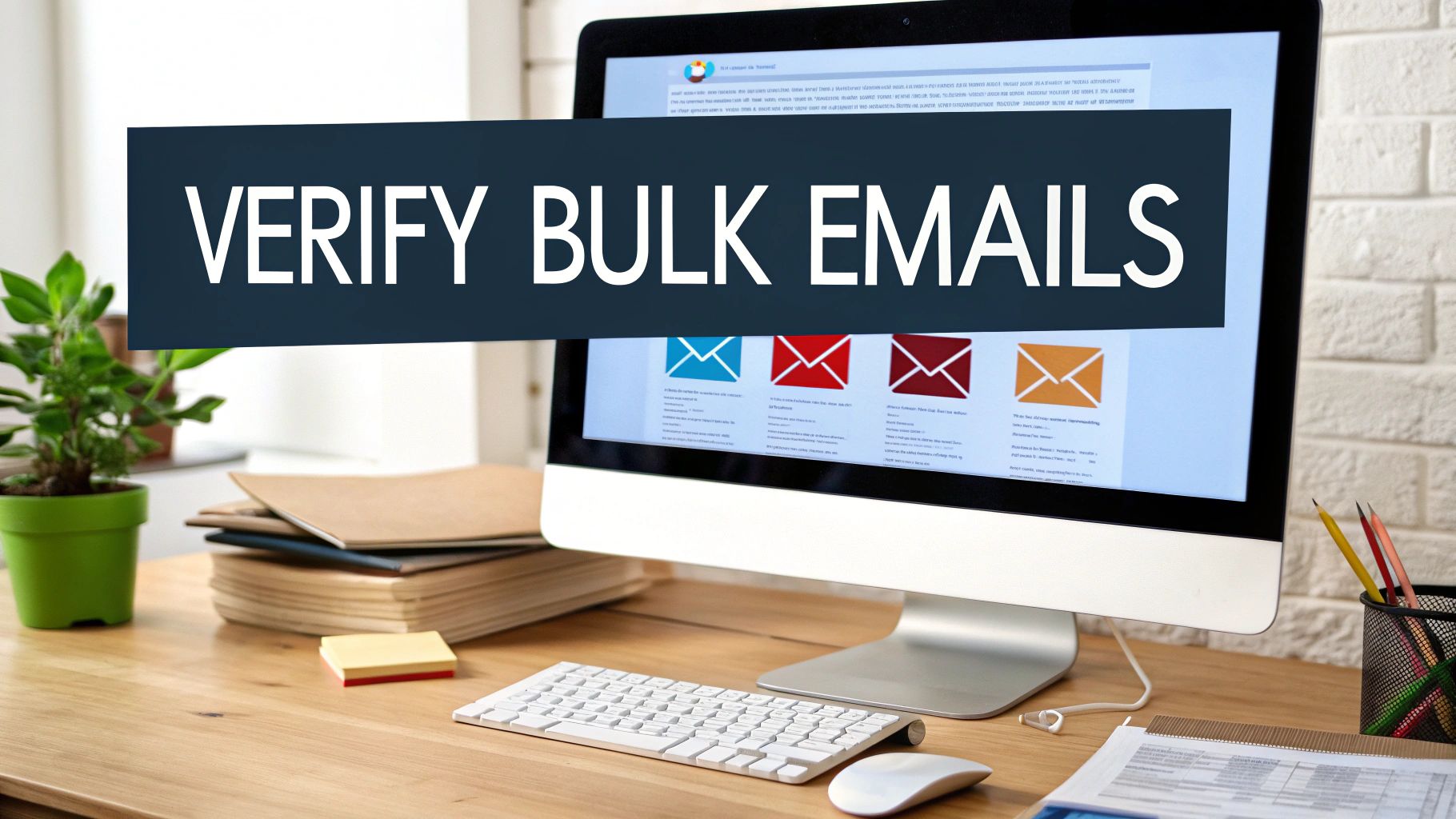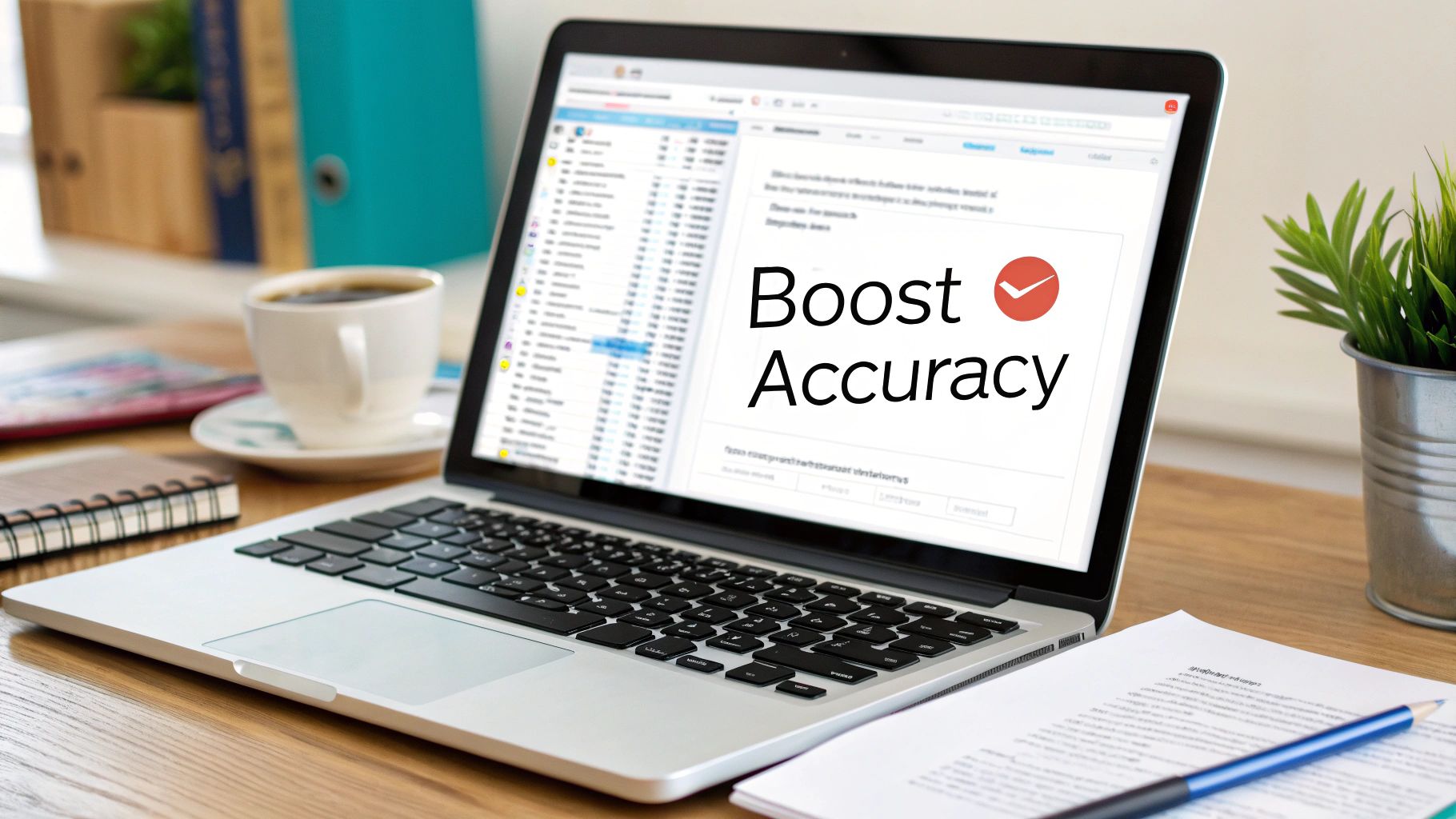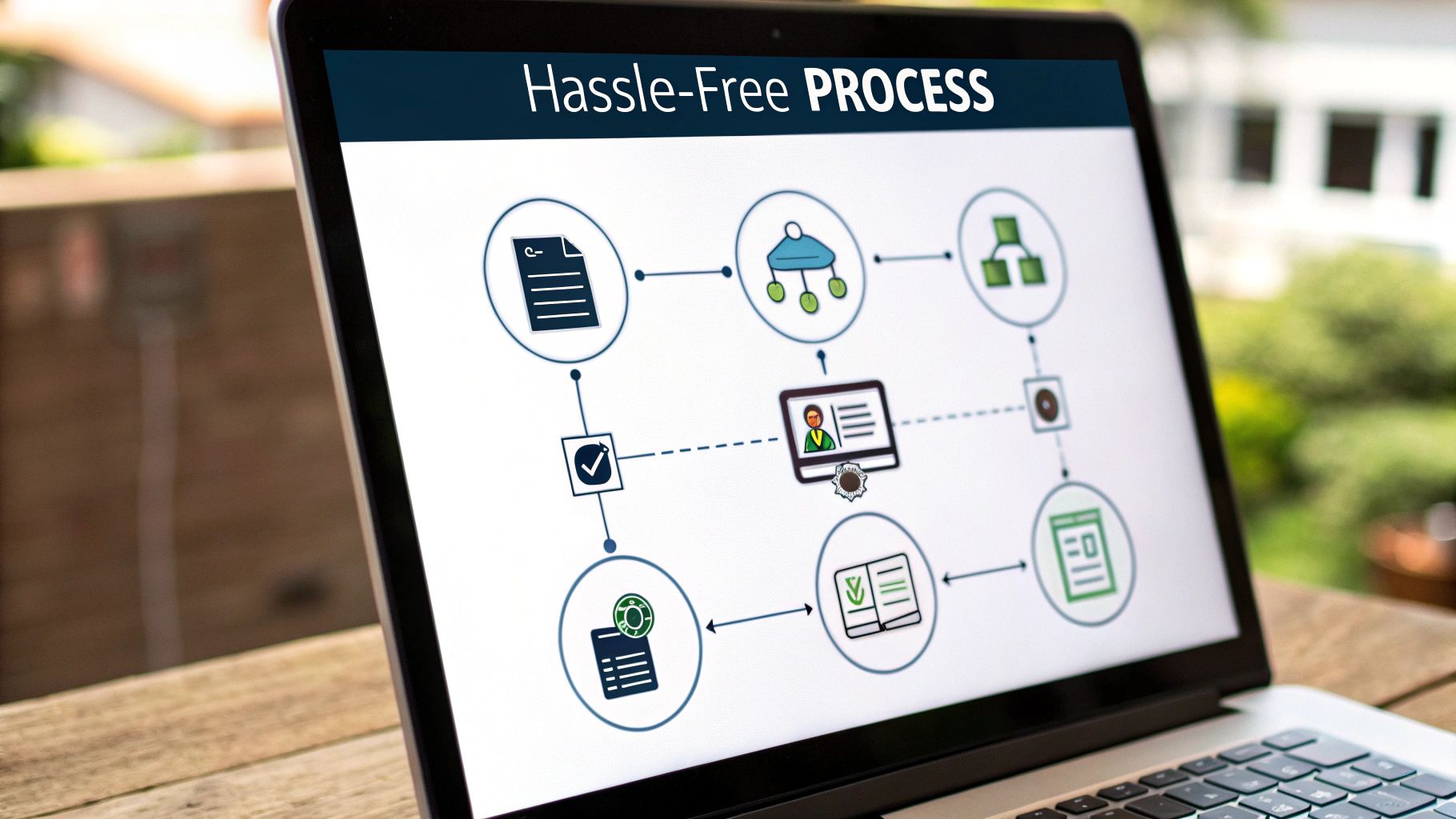Understanding Email List Decay and Your Bottom Line
A clean and active email list is essential for successful email marketing campaigns. Over time, email lists naturally degrade through a process called email list decay. When you send emails to invalid addresses, you’ll see higher bounce rates that can harm your sender reputation and potentially get you blacklisted. This directly impacts your ability to reach customers and get returns on your marketing investment.
Several factors contribute to email list decay. People frequently change jobs and email addresses, while others may simply lose interest in your content or mark messages as spam. As invalid and inactive addresses accumulate, it becomes harder to effectively reach your target audience.
Email bulk verification tools help combat list decay by identifying and removing problematic addresses. Research shows email lists decay by approximately 3% each month – meaning a list of 10,000 contacts could lose 300 valid addresses monthly. To maintain optimal deliverability, experts recommend verifying your list quarterly, or more often for frequent senders. Learn more about bulk verification at Emailable’s bulk verification service.
The Hidden Costs of Ignoring List Decay
Poor list maintenance creates problems beyond wasted resources. High bounce rates damage your reputation with email providers, potentially causing your messages to be marked as spam. Bad data also skews your campaign metrics, making it difficult to measure success and plan future campaigns effectively. For additional email marketing tips, check out our complete resources.
Proactive Strategies for Combating Email List Decay
To keep your email list healthy and protect your marketing efforts, implement regular verification checks using quality bulk verification tools. Use double opt-in to ensure new subscribers are engaged from the start. Break your list into segments based on subscriber interests and engagement levels, then customize content for each group. This targeted approach helps maintain subscriber interest and reduces unsubscribes. Taking these proactive steps will help your email marketing deliver better results and support your business goals.
Mastering Deliverability Through Smart Verification
Getting your emails to actually reach inboxes is essential for effective email marketing. While great content matters, it means nothing if your messages never arrive. Email bulk verifiers play a key role here – they help ensure your emails land in inboxes rather than spam folders or dead accounts. This helps protect your sender reputation and gets better results from your campaigns.
How Verification Tools Enhance Sender Reputation
Quality verification tools check email addresses in several important ways. First, they perform syntax verification to catch basic errors like typos and missing characters that could cause bounces. They also analyze server responses to spot invalid or inactive accounts. These checks help keep your email list clean and maintain your sender score.
The tools also flag role-based accounts like info@ or sales@ addresses. Though these may look valid, they often go to multiple people and aren’t ideal for personalized marketing. Removing them lets you focus on real individuals and reduces spam complaints. This targeted approach helps your campaigns succeed.
Tools like Hunter’s Bulk Email Verifier can dramatically improve deliverability by keeping bounce rates under 1%. This happens through detailed verification of syntax, format, and server responses – all without sending test emails. While even verified addresses can occasionally bounce due to technical issues, using a bulk verifier greatly reduces this risk and helps your campaigns perform better.
Interpreting Verification Results and Implementing Changes
Understanding verification results is crucial for maintaining your email list. Good verification tools sort addresses into clear categories – valid, invalid, catch-all, and unknown. This helps you decide what to do with each address. For example, you’ll want to remove invalid emails right away, but catch-all addresses need more careful consideration.
After cleaning your list based on verification, be sure to improve your overall email practices. Focus on segmenting subscribers by engagement and interests, personalizing your messages, and verifying addresses regularly. These steps help build a quality email list that connects with engaged readers consistently.
“Essential Features That Drive Verification Success”
Essential Features That Drive Verification Success
Finding the right email verification tool requires understanding which features matter most. The right combination of capabilities helps ensure accuracy, efficiency and return on your investment. Here are the key features to look for when choosing an email bulk verifier.
Real-Time Verification: Instant Feedback for Optimized Efficiency
Quick verification as emails are entered helps catch invalid addresses before they enter your database. This works great for web forms and signups since it blocks bad emails right away. By preventing invalid emails upfront, you avoid the hassle of cleaning up messy lists later.
Advanced Bulk Processing: Handling High Volumes with Ease
For businesses with large email lists, processing thousands of addresses quickly is essential. A good bulk verifier should maintain both speed and accuracy even with big datasets. This matters most when you’re dealing with growing lists that need regular verification.
Seamless Integrations: Streamlining Your Workflow
The ability to connect with your existing tools saves time and prevents errors. Look for verifiers that work with platforms like Salesforce and other email marketing systems you use. When verification flows smoothly into your workflow, you can focus on running effective campaigns.
Comprehensive Reporting: Actionable Insights to Guide Your Strategy
Detailed reports help you understand your list quality and make smart decisions. Good tools show clear breakdowns of valid, invalid, and catch-all addresses. These insights guide better email practices. For example, knowing what percentage of your list uses catch-all addresses helps shape your sending strategy. Research shows 10-30% of companies use catch-all email addresses.
Identifying Disposable and Catch-All Emails: Navigating Complexities
The best verifiers can spot both disposable and catch-all addresses. Disposable emails used for one-time signups can bloat your list size. Catch-all addresses may be valid but have higher bounce risks. Having this insight lets you handle these addresses appropriately. Studies indicate 60% of emails in the US are disposable emails.
By flagging both types of addresses, you maintain cleaner lists and more effective campaigns. Understanding how a verifier handles these nuances helps you pick the right tool for your needs and get better results from your email marketing.
Building Your Email Verification Strategy
Creating an effective email verification plan helps you maintain quality subscriber lists and get better results from your email campaigns. Let’s look at the key elements of a strong verification strategy that will help protect your sender reputation and keep your email list healthy.
Determining Your Verification Frequency
The right verification schedule depends on your specific needs. If you send emails frequently, you’ll want to verify more often than someone who sends less regularly. List size is also important – bigger lists typically need more frequent cleaning. Most email experts recommend verifying every 2-3 months or before major campaigns.
The type of list matters too. Lists that were purchased or haven’t been verified recently need immediate checking. Well-maintained lists with high engagement may need less frequent verification. For more resources, check out: EmailAddress.ai’s resource library.
Segmenting Your List for Efficient Verification
Breaking your list into smaller groups makes verification more manageable and effective. Try segmenting by engagement levels or subscriber demographics. This focused approach helps you identify which parts of your list need the most attention and lets you adjust your list-building methods accordingly.
Timing Your Verification Runs Strategically
Don’t wait for problems to appear before verifying your list. Make verification a regular part of your email maintenance routine. Check your list before important campaigns like product launches or special promotions. This helps ensure your messages reach the right people at the right time.
Interpreting Verification Results and Taking Action
After verification, you’ll get a report showing different types of email addresses. Valid emails are good to use, while you should remove invalid emails right away. Catch-all emails need careful consideration – they might work but have higher bounce risk. Research shows 10-30% of companies use catch-all addresses. Disposable emails should be removed since they’re typically temporary – studies indicate up to 60% of US email addresses are disposable.
Understanding these categories and following a consistent verification plan helps maintain a clean email list. This leads to better delivery rates, more successful campaigns, and improved results from your email marketing efforts.
Measuring and Maximizing Verification ROI
Using an email bulk verifier improves email marketing effectiveness – but measuring the return on investment goes beyond just counting valid email addresses. Let’s look at how to measure success through key performance metrics and understand the actual cost savings achieved.
Key Performance Indicators to Track
The most important metric to watch is your bounce rate reduction. When bounce rates drop, it means your list is cleaner and your emails are more likely to reach inboxes rather than spam folders. For example, reducing bounces from 5% to 1% means 4% more of your audience receives your messages.
Pay attention to your open and click rates too. Higher engagement shows your emails are finding the right subscribers. Also monitor your unsubscribe rate – while some unsubscribes are normal, a spike after verification often means inactive contacts have been removed, leaving your most engaged readers.
Keep track of your email sending costs. With fewer invalid addresses, you’ll typically spend less, especially if your email service charges per message sent.
Quantifying Cost Savings: A Practical Approach
To calculate savings, determine the cost of each bounced email including wasted sending fees, missed sales opportunities, and reputation damage. Then multiply by the number of bounces prevented.
For instance, if each bounce costs $0.50 and verification prevents 1,000 bounces, that’s $500 saved – a clear return on your verification investment.
Communicating Value to Stakeholders
Show stakeholders the impact through clear data and visual charts highlighting improvements in bounce rates, open rates, and cost reduction. Emphasize ongoing benefits like better sender reputation, increased deliverability, and higher engagement.
Optimizing Your Verification Spend
Consider how often to verify based on your list size and email frequency. Some companies need monthly verification while quarterly works for others. Review your specific needs and industry standards.
Look carefully at verification provider features. Real-time verification, email platform integrations, and detailed reporting can help improve results. Picking the right provider and verification schedule directly affects your ROI. Focus on measurement, cost analysis, and clear communication to show the value of verification.
Emerging Trends in Email Verification
Email verification continues to advance with new methods and technologies being developed to boost accuracy and efficiency. Several key factors drive these changes, including AI developments, stricter privacy rules, and growing security needs. For businesses using email marketing, keeping up with these changes is essential.
AI and Machine Learning Adoption
Artificial intelligence (AI) and machine learning (ML) are making email verification more powerful. These technologies create smarter systems that spot invalid emails with greater accuracy than before. For instance, AI analyzes email patterns to catch disposable addresses and spam traps that older methods might miss. The result? Cleaner email lists and better delivery rates. ML systems also get smarter over time as they process more data, helping fight list decay.
Better Security and Privacy Protection
Email verification services now focus heavily on data protection to meet regulations like GDPR and CCPA. Security has become a top priority, with verification tools adding stronger safeguards against unauthorized access and data breaches. This helps keep sensitive email data safe while meeting legal requirements.
What’s New in Features
Email verification tools keep getting better. Real-time verification checks emails the moment they’re entered, stopping bad addresses before they get into your database. Bulk verification has also improved – systems can now check huge email lists faster than ever. Want to learn more? Check out EmailAddress.ai’s resources. These improvements give businesses more control over their verification process.
Keeping Up With Changes
Using modern email verification helps campaigns succeed. Companies that use these new tools see:
- Higher delivery rates
- Fewer bounced emails
- Better sender reputation
This leads to stronger campaign results and better connections with subscribers.
Want to try advanced email verification yourself? Visit EmailAddress.ai to see how our accurate service can improve your email marketing.





